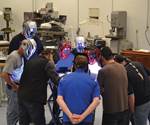How Will Industry 4.0 Impact Mold Maintenance?
Many toolrooms want to replace manual entries with electronic data when creating maintenance work orders and providing past historical issues, corrective actions and the effectiveness level of resolutions, but technicians require more information than electronic signals can provide to prove a return on investment of their time.
Industry 4.0 has been getting a lot of attention from molders as they look to take advantage of connecting processing information with production information to efficiently produce quality parts on time. This common goal is the tagline for the MoldTrax electronic maintenance system. For example, MoldTrax collects, analyzes and shares accurate data to drive business success. It only makes sense that as the 4.0 culture continues to grow within the molding industry, the mold repair side of the business starts asking: “What’s in it for me?”
Maintenance professionals need to understand how or if a 4.0 culture can help them do a better job of troubleshooting and maintaining their molds, and which piece of this broad range of electronic data could be useful in both short- and long-term maintenance plans. Here is a look at the electronic benefits that are possible for mold repair.
Electronic data will provide insight, helping technicians to determine the proper corrective action. However, electronic data is not enough on its own.
Data Devices
In a typical firefighting repair culture, toolroom technicians do not always know where to start, so they begin at the end and work backward. They examine live electronic data on molding parameters available through products that bolt on or wire into a mold or press. The challenge is knowing what data helps improve troubleshooting efforts and corrective action resolutions.
Five basic functions of these data devices are the date and time that a mold started and stopped, the shot or cycle count (over a lifetime or recently), cycle time (minimum/maximum/average), mold/cavity sensors (the injection pressure, temperature, melt viscosity and clamp pressure) and sensor or micro-switch failures. These features are captured through an electronic signal and fed to numerous host systems, which analyze the information and then feed it back to the user in a report, graph or chart that provides clues to the current mold or part situation. Each supplier configures the data to “signal” the usefulness of the information to various segments of a molding operation.
From there, a technician must determine the value of this data. At first glance, the data can serve as an alert function when something is amiss or when a technician is attempting to solve an issue with the mold, part, press or people. For example, the data indicates when a preventive maintenance (PM) run is due or overdue, how many cycles are run during a specific timeframe, if a mold cycle time is in or out of an accepted range, when the mold starts or stops, how long a machine is idle or down and when process conditions exceed a set range.
Once this data is implemented and tested, and technicians have determined a verified range, they can maintain a more consistent process, which helps them troubleshoot mold function and part quality issues and more accurately forecast tooling life. Without process consistency, it can be difficult—if not impossible—for technicians to determine a root cause, leaving them with few options, like simply cleaning the mold or sticking in new tooling and hoping the issue magically disappears.
Sometimes the issue does disappear, which provides a continued endorsement of a costly, firefighting maintenance strategy. In reality, the issue disappeared because something in the process changed, not the inclusion of new tooling. For example, injection pressure spiked during the run and caused flash, someone increased clamp pressure and eliminated flash, a technician turned up the nozzle heaters too high, the mold sat idle for too long, or the mold overran its specified PM cycle count. Electronic data will provide insight into these situations, helping technicians to determine the proper corrective action. However, electronic data is not enough on its own.
Defect position analysis is at the heart of a continuous-improvement maintenance strategy, arming repair technicians with the right data to make more informed decisions.
More Than Data
It takes human interaction to fill in the blanks that these live data signals create. Before a toolroom tackles an issue, the technicians need to know exactly which issue that they should examine. It takes skilled technicians to prioritize the issues that they must investigate. Some larger companies have thousands of documented mold and part issues in their databases. Imagine trying to chase all the “out-of-range” issues that live electronic signals provide.
For example, what if during only one run, a host system was flagged indicating that a mold experienced a clamp or an injection pressure increase along with a cycle time and mold temperature change? What if the result of these changes were negligible and the mold still produced good parts during the run? What if the mold had a couple of cavities blocked for non-fill, flash or a burn during a run? The answer is unclear. The technician either sets up a DOE (Design of Experiment) to chase these process-related issues or hopes that they go away during the next production run. Perhaps the data is so confusing that the best answer is to stick in new tooling, give it a good cleaning and hope for the best.
As useful as some electronic data is, these signals will not tell technicians:
- Why a mold stopped.
- Where and when a runner or part got hung up.
- The material status.
- The occurrence of the tooling or the component galling or locking up.
- The corrective action that was taken, when it was performed, the technician who was responsible or the length of time that the action took.
- The tooling that was required for the corrective action.
- The mold or cavity position of the defect occurrence.
- The reason that the press door was opened (which shut down the operation).
- Which operator was on break, leaving the door open.
- The part quality issues.
- The mold life.
- The frequency and maintenance costs of the issues.
Human involvement will provide clarity to these issues. Technicians must enter data manually to document the issues that stop or slow production and create substandard parts. Once the issues are documented, technicians must monitor the issues to prioritize targets and goals accurately based on frequencies, tooling and labor costs and critical customer requirements.
The toolroom team must set goals and targets based on actual mold performance issues to ensure that the issues they are chasing through DOEs or root cause analysis are worth the effort.
Typically, when a mold lands on a bench for PM and repair, a work order spells out the current issues that the repair technician must address. A continuous improvement culture requires technicians to identify what they need to fix now and the high-frequency or high-cost issues that have plagued the mold during past runs and the typical corrective actions. Technicians should also perform defect -osition analysis to identify defect patterns and trends quickly. This analysis is at the heart of a continuous improvement maintenance strategy, arming repair technicians with the right data to make more informed decisions.
The bottom line is that most molders, including toolroom managers, are too busy with daily activities to chase every parameter that is electronically signaled to be “out of range” or “suspicious” or that “could” cause an issue. The toolroom team must set goals and targets based on actual mold performance issues (with manual entries) to ensure that the issues they are chasing through DOEs or root-cause analysis are worth the effort.
Electronic data and the range of connectivity surely will improve a toolroom’s ability to produce quality parts on-time and efficiently, but in the world of maintenance, entries that are accurate and manual will always be required to give technicians the necessary information to attack real issues and measure real improvement.
About the Contributor
Steve Johnson
Steve Johnson is president of MoldTrax, which provides specialized course work, hands-on bench training, maintenance software, maintenance products, toolroom design and maintenance efficiency auditing.
Related Content
Women Impacting Moldmaking
Honoring female makers, innovators and leaders who are influencing our industry's future.
Read MoreMMT Chats: Marketing’s Impact on Mold Manufacturing
Kelly Kasner, Director of Sales and Marketing for Michiana Global Mold (MGM) talks about the benefits her marketing and advertising, MGM’s China partnership and the next-generation skills gap. This episode is brought to you by ISCAR with New Ideas for Machining Intelligently.
Read MoreMMT Chats: Acquisition Trends and Lessons for Mold Builders
Jim Berklas is a former full-time M&A lawyer for several of the largest private equity firms in the country and has 25 years of M&A experience and 200 closed transaction. Today, he is founder and M&A Leader with Augmented Industry Services. He joins me for this MMT Chat on mergers and acquisitions trends and strategies within in the mold manufacturing industry. This episode is brought to you by ISCAR with New Ideas for Machining Intelligently.
Read MoreICYMI: MMT Chats: True Leadership Leads to Mentoring, Part 1
This trio from TK Mold and Engineering in Romeo, Michigan, joins me to discuss the role of leadership and culture in mentorship. This episode is brought to you by ISCAR with New Ideas for Machining Intelligently.
Read MoreRead Next
Maintenance Matters: Cultivating Craftsmanship
Toolroom managers need to help repair technicians become skilled mold troubleshooters and craftsmen rather than tooling replacers and cleaners.
Read MoreHow to Use Strategic Planning Tools, Data to Manage the Human Side of Business
Q&A with Marion Wells, MMT EAB member and founder of Human Asset Management.
Read MoreAre You a Moldmaker Considering 3D Printing? Consider the 3D Printing Workshop at NPE2024
Presentations will cover 3D printing for mold tooling, material innovation, product development, bridge production and full-scale, high-volume additive manufacturing.
Read More




















.png;maxWidth=300;quality=90)








